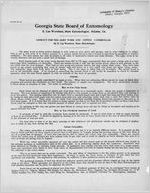Untvel"l1tY of Geotla Llbranes
Athens, Georgia 30602
Circular No. 12.
Georgia State Board of Entomology
E. Lee Worsham, State Entomologist, Atlanta, Ga.
LOOKOUT FOR THE ARMY WORM A D COTTO CATERPILLAR. By E. Lee Worsham, State Entomologist.
. . The army worm is doing serious damage to such crops as corn, grain and grasses, and in some instances to cotton. ThIs. I.S not a new pest; it is always present to a certain extent but as a rule it is held in subjection by parasites or weather condItIons. The past season has been favorable to all kinds of destructive insects and plant diseases. The army worm is unusually abundant and has done a great deal of damage.
. Each female moth of the army worm deposits from 500 to 700 eggs, consequently they can cover a large area in a very short tIme when conditions are favorable. There are several broods a year but the second brood, which is now present, is the one which does the most damage. They feed on corn, grain and grasses mainly, but may attack other crops. They have been known to eat almost everything they come in contact with and travel at a very rapid rate, hence the name "army worm." The caterpillar stage lasts from three to four weeks. This is the stage at which they can be fought. The second brood is now in the caterpillar stage. If we succeed in controlling the present brood it will hardly be necessary to resort to remedial measures when the next brood appears in July on account of the work of parasites.
Control
These worms are easily controlled if we begin in time. When they are advancing efforts should be made to cheek their progress and prevent the infestation of other fields. The remedy is simple and inexpensive. The most satisfactory remedy if> Paris Green or arsenate of lead. The latter is preferable.
How to Use Paris Green.
Paris Green can be obtained at almost any local drug store at a reasonable price. About one pound is neeessary to the acre. The best method of applying is by mixing with four or five pounds of cheap flour or air-slacked lime and dusting it on to the plants. The dusting apparatus can be made from a one-inch board, four and a half feet long and three inches wide, by boring an inch and a half auger hole five inches from each end, and attaching under each hole a sack five inches wide by about fifteen inches long. These sacks can be made from unstarched sheeting running about four pounds to the yard or of corn-meal sacks. If it is found that the poison is being applied too fast or too slow, the proportions of lime (or flour) and Paris Green must be changed so that the required amount of actual poison will be applied per acre.
By applying in this way one person can dust fifteen to twenty acres per day by riding on horseback and dusting as he passes between the rows.
How to Use Powdered Arsenate of Lead.
If arsenate of lead is used the powdered form should be employed. It can be used alone or with an equal quantity of flour or air-slacked lime. It should be applied by dusting as in the case of Paris Green and at the rate of about three pounds' of the arsenate of lead per acre.
The best time to dust is in the early morniag or late afternoon but satisfactory results can be obtained if application is made at any time during the day.
Cotton Caterpillar.
The cotton caterpillar is sometimes called the army worm but it is an entirely different insect. It is present at this time in Texas and there is every reason to believe that it will appear in Georgia during the growing season at the time when it can do a great deal of damage. It came last year but too late to injure the cotton crop very materially. There are records where the cotton crop of Georgia has been injured fully 50 per cent. and it could do equally as much damage this year if it were to break out during July or August.
While the cotton caterpillar appeared all over the cotton belt last season none of the insects wintered over except In the extreme southern or southwestern part of the cotton belt. It is advancing rapidly from the southwest. Specimens may have wintered in Florida or extreme south Georgia. It multiplies very rapidly and can cover vast areas in a single season. Last year specimens were taken in New York state, in Massachusetts and even in Canada during the fall and they came from the outbreak in the cotton states.
This is an insect that can be easily controlled. The only thing of importance is for the cotton grower to be prepared at the time the first specimens mak~ th~ir appearance. Be ready. to appl: the Pari~ Gree~ or arsen!lte of lead when the first specimens are observed. One apphcatlOn WIll probably be suffiCIent to gIve protectIOn durmg an entIre season.
The powdered arsenate of lead has wonderful adhesive powers and the poisonous effects remain as long as the leaves cling to the plant. When specimens are observed on the cotton plant they should be sent at once to the State Entomologist so that detailed directions can be given for applying the poison.
Paris Green can be purchased at almost any drug store. Powdered arsenate of lead can be purchased from Lamar & Rankin Drug Co. Atlanta Mallary Mill Supply Co., Macon, Ga., Berckmans Bros., Augusta, Ga., Southern Brokerage Co., or Ft. Valley Lumber Co., Fort Valley, Ga., Durr Drug Co., Montgomery, Ala., or Grasseli Chemical Co., Birmingham, Alabama.
r
r
